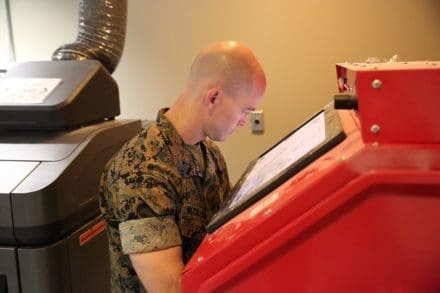
MARINE CORPS BASE QUANTICO, Va. —
The University of California San Diego Medical Center has requested Marine Corps Systems Command’s assistance to help medical professionals as they deal with the evolving crisis of COVID-19.
On March 16, Dr. Sidney Merritt, an anesthesiologist at UCSD Medical Center, contacted MCSC’s Advanced Manufacturing Operations Cell requesting assistance in coordinating 3D printer assets to design parts to enable the simultaneous ventilation of multiple patients.
AMOC initiated collaboration with the Naval Information Warfare Center Pacific Reverse Engineering, Science and Technology for Obsolescence, Restoration and Evaluation Lab to rapidly design, print, test and evaluate prototype ventilator splitters using various materials.
The AMOC team also worked with the Navy’s Bureau of Medicine and Surgery for support in evaluating, certifying and approving the parts prior to delivery to the medical center.
MCSC, NIWC Pacific and UCSD have established a Cooperative Research and Development Agreement to facilitate current and future support requests. A Memorandum of Understanding among MCSC, NIWC Pacific and the Navy’s Bureau of Medicine and Surgery is also being established to codify roles and responsibilities.
MCSC’s involvement
On March 18, Merritt provided design files for the ventilator splitter based upon a successful test print conducted by the UCSD engineering team. UCSD requested assistance in printing ventilator splitters in higher resolution and with diverse materials that could meet specific design requirements.
After receiving the design files, AMOC and the NIWC Pacific RESTORE lab printed several prototypes using different materials. In less than a day, AMOC used its industrial printer in Quantico, Virginia, and the RESTORE Lab employed its organic printers to produce initial prototypes.
The 3D-printed ventilator splitters were scanned to ensure accuracy with the design files and then brought to UCSD Medical Center for fit testing and further design analysis.
AMOC’s reputation in advanced manufacturing has grown since its establishment in 2019. The cell has demonstrated the ability to produce 3D-printed parts and provide other sustainment and manufacturing solutions in a timely fashion. When called upon, the AMOC can produce parts in a fraction of the time it takes traditional manufacturers.
“AMOC’s response to this situation demonstrates how additive manufacturing can respond quickly to supply chain disruptions and rapidly prototype, evaluate and test new solutions to meet emerging urgent requirements,” said Scott Adams, AMOC lead at MCSC.
The rapid response by AMOC and the NIWC Pacific RESTORE lab to UCSD Medical Center’s request for support is indicative of how the Department of the Navy is prepared to respond to the medical community during the COVID-19 crisis.
“I couldn’t be prouder of the Marine Corps and NIWC Pacific team,” said Carly Jackson, NAVWAR Chief Technology Officer. “We are demonstrating the power, agility and speed of response that our Naval research and development centers bring to bear in times of national need.”
By Matt Gonzales, MCSC Office of Public Affairs and Communication | Marine Corps Systems Command

